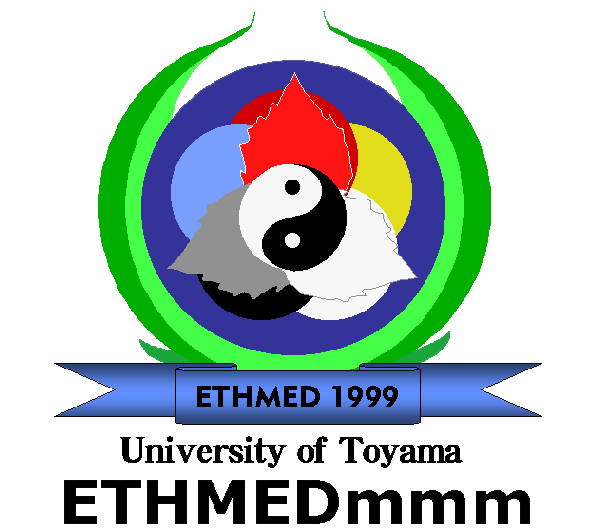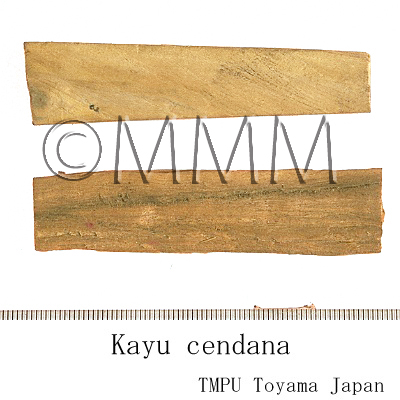Crude drug sample data base
※Click on the image to enlarge it.
Scientific information data base
| Crude drug name | Indonesian name, English name | Cendana, Sandalwood | ||||
|---|---|---|---|---|---|---|
| crude drug image |
| |||||
| Original plant name | Santalum album Linn. | |||||
| Family name | Santalaceae | |||||
| Used part | Wood | |||||
| Distribution area | It is cultivated in Java and east part of Madura Island of Indonesia up to 1200 altitude, in dry, rocky or hardened soil savannah, in grassland with volcanic soil. It is cultivated in shinny and mountainous areas in Timor, Sumba, Flores Islands in eastern part of Indonesia [201]. | |||||
| Description | Heartwood light yellowish brown when freshly cut, turning dark brown on exposure, and with further aging, to a dark reddish brown; sapwood whitish. Texture very fine and even; grain straight, sometimes wavy; dull to somewhat lustrous, with oily feel; heartwood with a strong fragrant scent that persists, without characteristic taste. It is a tree up 12-15 m tall with many opposite slender branches, bark grey-brown. Leaves glabrous, thin, elliptic-ovate; flowers straw-coloured, brownish purple, reddish purple or violet, unscented. Drupe globose, purple-black with hard, ribbe endocarp; seeds globose or obovoid. | |||||
| Drug effect | Cooling. | |||||
| Specific actions | Antipyretic, analgesic, carminative, stomachic, diuretic [231]. | |||||
| Frequency in use | Moderate. | |||||
| Common uses | The wood has an aromatic odour. Essential oil obtained from the wood is used as a perfume and cosmetics for its skin softening property. It is also used as an incense [201]. | |||||
| Pharmacological effect | East Indian Sandalwood is used for the treatment of somatic and mental disorders. An investigation is conducted to study the effects of inhalation of East Indian Sandalwood essential oil and its main compound, alpha-santalol, on human physiological parameters (blood oxygen saturation, respiration rate, eye-blink rate, pulse rate, skin conductance, skin temperature, surface electromyogram, and blood pressure) and self-ratings of arousal (alertness, attentiveness, calmness, mood, relaxation and vigor) in healthy volunteers. Correlation analyses revealed that these effects are mainly due to perceived odor quality. Results suggest a relation between differences in perceived odor quality and differences in arousal level [PMID:16783696]. | |||||
| Medical system | Indonesian medicine (Jamu) | |||||
| Traditional usage | It has cooling property and can be used by mixing pounded heartwood with water to make sludge which can be applied externally on the whole body. Crushed wood is applied on the forehead to treat headache and protect face from sunburnt. Wood is crushed and steep in water and the water is drunk for several days to treat gonorrhea. The wood is also used to treat inflammation and used as a liniment. Stem and root bark is crushed , mixed with water and drink to treat irregular menstruation [201]. It is used to treat diarrhea, enterocolitis, dysentery and as antiseptic of urinary tract [231]. | |||||
| Formulation | 1) Skin care: Dried pounded wood is mixed with water to make a sludge, apply it externally all over the skin. When dries, wash skin with water thoroughly [207]. 2) Dysentery: 2 grams of cendana wood, 5 grams of leaves of Euphorbia prostata, a small amount of gambir from Uncaria gambier are mixed and boiled with 100 ml of water. Drink 100 ml of the decoction twice a day for 14 days [231]. 3) Inflammation of intestine: 2 teaspoon of powdered wood of S. album is boiled with 100 ml of water to make a decoction. Drink 100 ml of the decoction twice, in the morning and in the evening for 14 days [231]. | |||||
| References | Reference book Tips! | [201] K. Heyne, Tumbuhan Berguna Indonesia, Vols. 1-4, 1987. Diedarkan Oleh Koperasi Karyawan Departemen Kehutanan, Jakarta, Indonesia. Vol. 2, pp 714-71. [207] Badan Penelitian Dan Pengembangan Kesehatan and Departemen Kesehatan, Kesejahteraan Sosial Ri. Vols. 1-5, Inventaris Tanaman Obat Indonesia, Jakarta, Indonesia. Vol. 4 (1997), pp 163-164. [222] P.T. Eisai Indonesia: Medical Herb Index in Indonesia (Second edition).1995. pp 151-152. [231] Soedibyo, Mooryati: Alam Sumber Kesehatan: Manfaat dan Kegunaan (Natural resources for health. Benefits and uses). Balai Pustaka. 1998. pp 110-111. | ||||
| Research paper | 1. Heuberger E, Hongratanaworakit T, Buchbauer G. East Indian Sandalwood and alpha-santalol odor increase physiological and self-rated arousal in humans. Planta Med. 72(9):792-800, 2006. (PMID: 16783696) | |||||
| Remarks | [DNA sequences] HM235968, EU723760, EU723761, AY083670, AY083671 | |||||
| Last renewal date | 2024/03/11 | |||||






